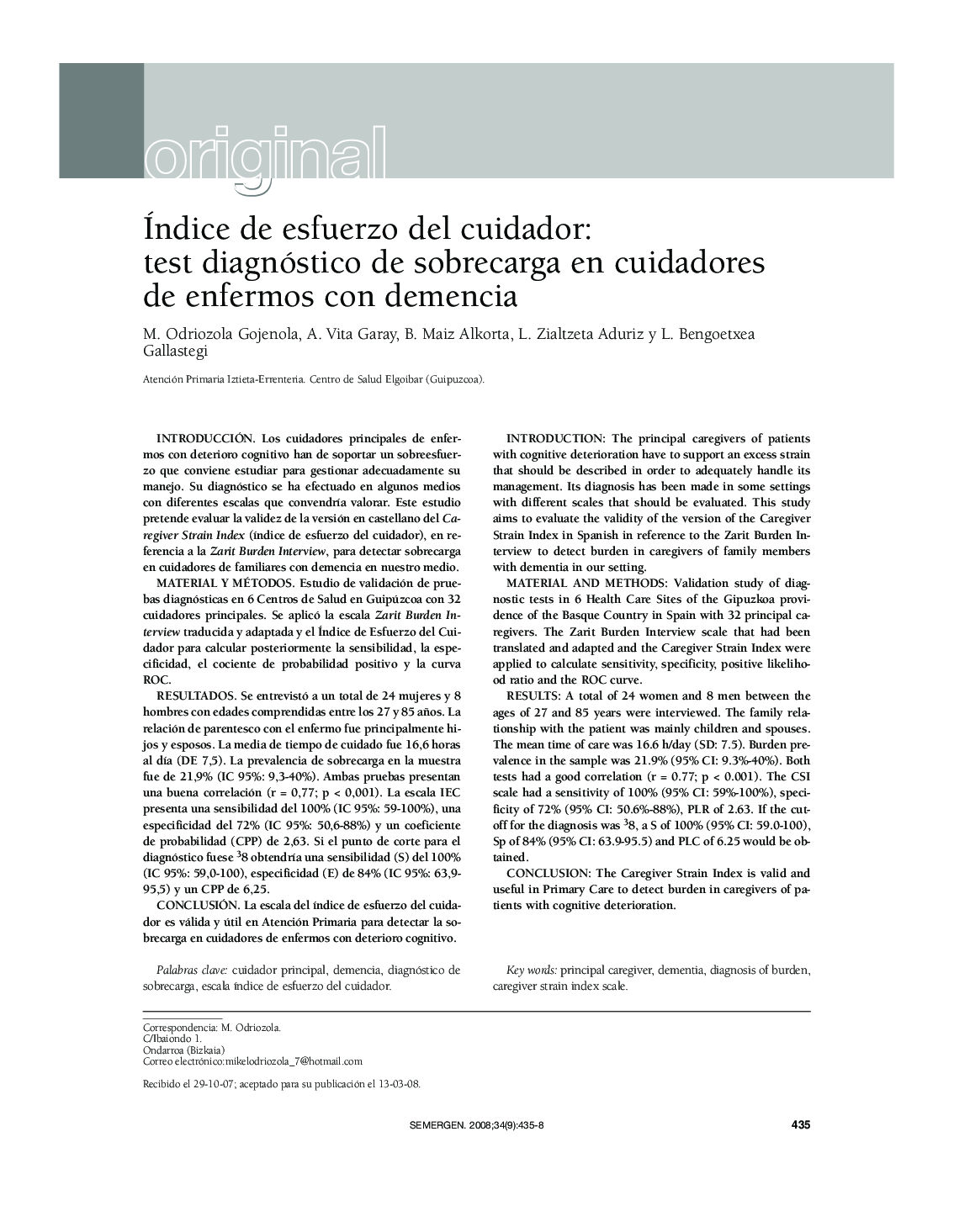| Article ID | Journal | Published Year | Pages | File Type |
|---|---|---|---|---|
| 3835571 | SEMERGEN - Medicina de Familia | 2008 | 4 Pages |
IntroducciónLos cuidadores principales de enfermos con deterioro cognitivo han de soportar un sobreesfuerzo que conviene estudiar para gestionar adecuadamente su manejo. Su diagnóstico se ha efectuado en algunos medios con diferentes escalas que convendría valorar. Este estudio pretende evaluar la validez de la versión en castellano del Caregiver Strain Index (índice de esfuerzo del cuidador), en referencia a la Zarit Burden Interview, para detectar sobrecarga en cuidadores de familiares con demencia en nuestro medio.Material y métodosEstudio de validación de pruebas diagnósticas en 6 Centros de Salud en Guipúzcoa con 32 cuidadores principales. Se aplicó la escala Zarit Burden Interview traducida y adaptada y el Índice de Esfuerzo del Cuidador para calcular posteriormente la sensibilidad, la especificidad, el cociente de probabilidad positivo y la curva ROC.ResultadosSe entrevistó a un total de 24 mujeres y 8 hombres con edades comprendidas entre los 27 y 85 años. La relación de parentesco con el enfermo fue principalmente hijos y esposos. La media de tiempo de cuidado fue 16,6 horas al día (DE 7,5). La prevalencia de sobrecarga en la muestra fue de 21,9% (IC 95%: 9,3-40%). Ambas pruebas presentan una buena correlación (r = 0,77; p < 0,001). La escala IEC presenta una sensibilidad del 100% (IC 95%: 59-100%), una especificidad del 72% (IC 95%: 50,6-88%) y un coeficiente de probabilidad (CPP) de 2,63. Si el punto de corte para el diagnóstico fuese 38 obtendría una sensibilidad (S) del 100% (IC 95%: 59,0-100), especificidad (E) de 84% (IC 95%: 63,9- 95,5) y un CPP de 6,25.ConclusiónLa escala del índice de esfuerzo del cuidador es válida y útil en Atención Primaria para detectar la sobrecarga en cuidadores de enfermos con deterioro cognitivo.
IntroductionThe principal caregivers of patients with cognitive deterioration have to support an excess strain that should be described in order to adequately handle its management. Its diagnosis has been made in some settings with different scales that should be evaluated. This study aims to evaluate the validity of the version of the Caregiver Strain Index in Spanish in reference to the Zarit Burden Interview to detect burden in caregivers of family members with dementia in our setting.Material And MethodsValidation study of diagnostic tests in 6 Health Care Sites of the Gipuzkoa providence of the Basque Country in Spain with 32 principal caregivers. The Zarit Burden Interview scale that had been translated and adapted and the Caregiver Strain Index were applied to calculate sensitivity, specificity, positive likelihood ratio and the ROC curve.ResultsA total of 24 women and 8 men between the ages of 27 and 85 years were interviewed. The family relationship with the patient was mainly children and spouses. The mean time of care was 16.6 h/day (SD: 7.5). Burden prevalence in the sample was 21.9% (95% CI: 9.3%-40%). Both tests had a good correlation (r = 0.77; p < 0.001). The CSI scale had a sensitivity of 100% (95% CI: 59%-100%), specificity of 72% (95% CI: 50.6%-88%), PLR of 2.63. If the cutoff for the diagnosis was 38, a S of 100% (95% CI: 59.0-100), Sp of 84% (95% CI: 63.9-95.5) and PLC of 6.25 would be obtained.ConclusionThe Caregiver Strain Index is valid and useful in Primary Care to detect burden in caregivers of patients with cognitive deterioration.
